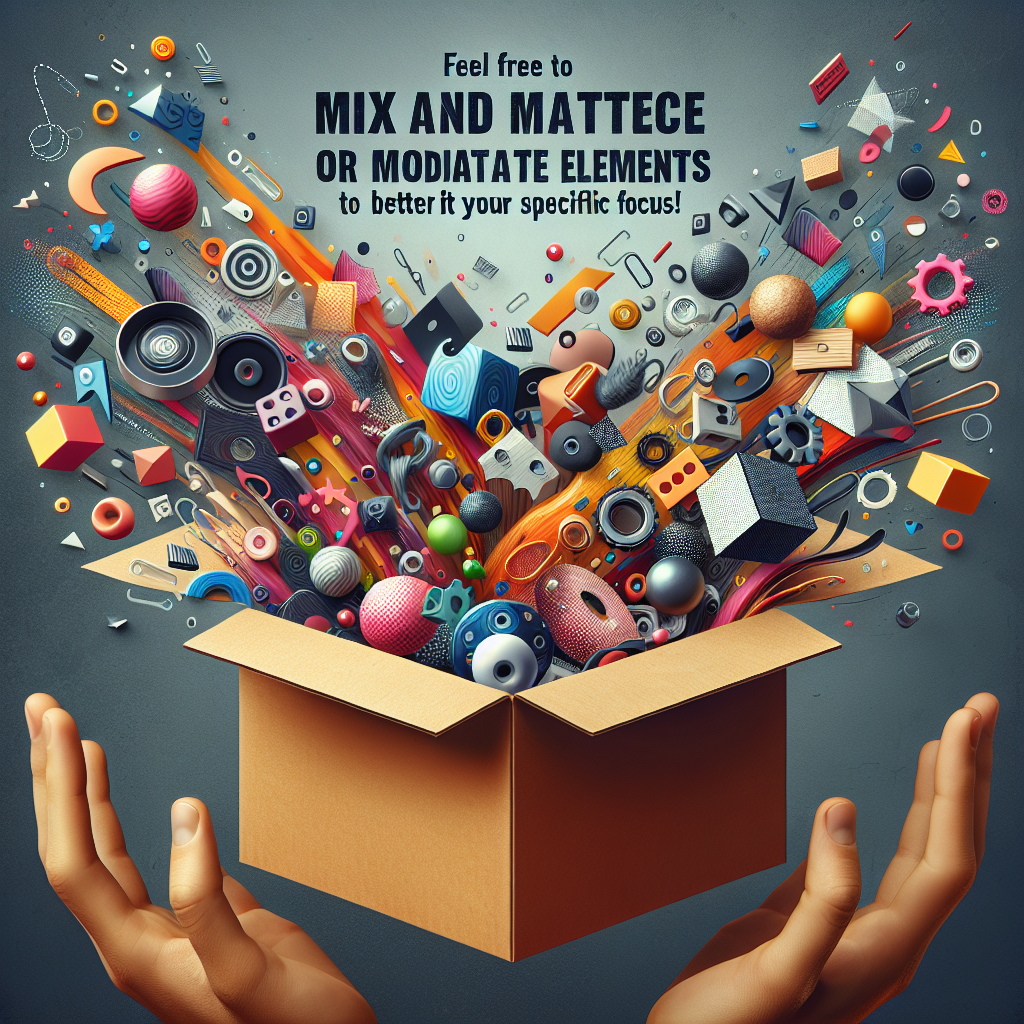Title: The Ultimate Guide to Customization: Feel Free to Mix and Match Elements or Modify Them to Better Fit Your Specific Focus!
Introduction
In a world bursting with choices, the power to customize and personalize something truly resonates with people. Whether it’s in design, branding, or personal development, the ability to "feel free to mix and match elements or modify them to better fit your specific focus!" can create impactful results that enhance satisfaction and efficiency. Beyond mere aesthetics, customization fosters creativity, ensuring relevance and engagement in various fields. This article explores the importance of customization and its real-world applications, helping you harness the power of modification to create extraordinary outcomes.
The Power of Customization
Understanding Personalization in Various Industries
Personalization isn’t a new concept; it has evolved through the years alongside technology and consumer needs. For example, in marketing, brands can segment audiences based on their interests, behaviors, and demographics, allowing them to deliver tailored messages. This principle—“feel free to mix and match elements or modify them to better fit your specific focus!”—is significant in various contexts.
Case Study: Nike’s Custom Shoes
Nike allows customers to design their shoes by choosing colors, materials, and even adding personal initials. This customization leads to higher customer satisfaction and brand loyalty. By embracing their customers’ choices, Nike has been able to thrive in a competitive market.
Customization in Marketing
Why Customization Matters
The importance of personalization in marketing cannot be overstated. It enhances customer experience and ultimately boosts conversions. When businesses allow their clients to feel empowered in their purchasing decisions—“feel free to mix and match elements or modify them to better fit your specific focus!”—they build relationships based on trust and satisfaction.
| Chart 1: Impact of Personalization on Conversion Rates | Personalization Level | Conversion Rate (%) |
|---|---|---|
| Generic Messaging | 2% | |
| Basic Personalization | 5% | |
| Advanced Personalization | 10% |
Customization in Design
Blending Aesthetics and Function
Visual representation plays a significant role in effective communication. When designers create graphics or layouts, they should keep in mind that audiences have diverse preferences. "Feel free to mix and match elements or modify them to better fit your specific focus!" is an approach that can lead to stunning results.
Case Study: Canva’s User-Friendly Design Platform
Canva is an online design tool that empowers users to create visually appealing layouts by offering various templates, images, and graphics. The flexibility of their platform allows users to modify elements to make their designs resonate with their audience’s expectations effectively.
Customization in Personal Development
Crafting Your Path
In the realm of personal growth, understanding one’s unique qualities enables individuals to identify their true potential. The concept of “feel free to mix and match elements or modify them to better fit your specific focus!” plays a vital role here as well.
For instance, creating a personalized action plan that incorporates various strategies—from time management techniques to mindfulness exercises—allows individuals to tailor their growth journey.
Case Study: The 5 AM Club by Robin Sharma
In this popular book, the author suggests that readers can adapt the principles shared to fit personal lifestyles, suggesting various routines that can be customized to meet individual goals.
The Risks of Over-Customization
Finding Balance
While customization is usually beneficial, there’s a fine line between personalization and over-complication. Making decisions too personalized can lead to information overload and decision fatigue. It’s essential to strike a balance and remember that "feel free to mix and match elements or modify them to better fit your specific focus!" doesn’t mean losing sight of the core message or design.
Conclusion
The potential for customization is vast, and it empowers people in various sectors to maximize their effectiveness, whether in marketing, design, or personal development. By understanding the significance of “feel free to mix and match elements or modify them to better fit your specific focus!”, you’re better equipped to engage your audience and create meaningful results. As you embark on your customization journey, remember the magic lies not just in what you choose to modify but in how those choices resonate with your specific goals.
FAQs
-
What does customization mean in marketing?
Customization in marketing involves tailoring messages, products, or experiences to meet the unique needs of specific audiences. -
How can I customize my professional brand?
You can customize your brand by selecting colors, logos, and messaging that reflect your personality and values, allowing you to resonate with your target audience. -
Is too much customization counterproductive?
Yes, over-customization can lead to confusion and indecision, as well as dilute the core message or service. -
How do I start personalizing my life?
Begin by identifying your values, setting achievable goals, and utilizing tools and strategies that align with your preferences. - Can customization improve customer loyalty?
Absolutely. When customers feel their specific needs are met, it fosters loyalty and encourages repeat business.
By understanding and embracing the idea of customization, you can elevate every aspect of your work and personal life. So, as you navigate your own path, remember that you have the unique ability to “feel free to mix and match elements or modify them to better fit your specific focus!" The power is in your hands.

